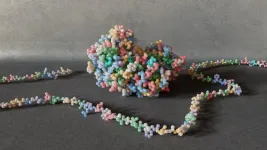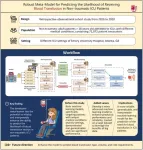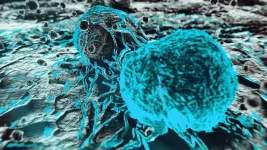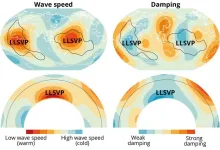(Press-News.org) Engineering and medical researchers at Penn have developed a groundbreaking framework that can determine the best and most computationally optimized distribution strategy for COVID-19 vaccinations in any given community. Published in PLOS One, this study addresses one of the most critical challenges in pandemic response — how to prioritize vaccination efforts in communities with individuals of different risk levels when supplies are scarce and the stakes are high.
The research team, comprised of Saswati Sarkar, Professor in Electrical and Systems Engineering (ESE), Shirin Saeedi Bidokhti, Assistant Professor in ESE, Harvey Rubin, a practicing physician at Penn Medicine and Professor of Infectious Diseases, and ESE doctoral student Raghu Arghal, designed their framework to be able to account for enough population complexity to determine the best and most applicable vaccination strategies, but not so complex that it becomes inaccessible to public health offices without high-powered supercomputers. What the researchers ended up creating was a highly adaptable framework that provides effective and unique strategies in a matter of seconds and only requires the computational power of a personal laptop.
Capturing Just the Right Amount of Complexity
Determining the best theoretical strategy for a vaccine rollout that includes all influencing parameters such as individual health metrics, location limitations and doses required, would typically take months or more, even with the massive computational power available today. This is because the size of communities over which such rollouts would need to be optimized can easily reach one million. For example, communities in the boroughs of New York City range anywhere from 0.5 to 2.7 million people.
“We needed an approach that would provide strategies on a more relevant timeline and require less computing power,” says Sarkar. “This was especially important to us as we wanted the framework itself to be accessible to low-resourced and remote communities, which are typically the most affected by disease outbreaks. We had to approach this real-world problem more practically while still using network theory tools that captured enough population heterogeneity to arrive at a meaningful and useful strategy.”
To achieve this “Goldilocks” level of complexity, the researchers defined three broad, yet representative groups:
High-Risk Group: Includes the elderly and immunocompromised individuals who are most vulnerable to severe forms of COVID-19 and death.
High-Contact Group: Essential workers, such as healthcare providers, teachers and grocery store employees, who are at high risk of spreading the virus.
Baseline Group: The rest of the population, who do not fall into the high-risk or high-contact categories.
Defining these distinct groups and leveraging the decades of research on optimal control frameworks, the team was able to use a numerical methodology with just the right amount of complexity that can offer unique and effective strategies for any given community.
Different Strategies for Different Communities
Not surprisingly, the framework showed that to reduce death tolls overall, it is best to vaccinate either the high-risk group or the high-contact group first, and the baseline last.
“The most common strategy, and the one that was deployed with the COVID-19 vaccines, vaccinates the high-risk group first,” says Saeedi Bidokhti. “But for 42% of the simulated instances, our framework shows that it is actually more effective to administer the vaccine to the high-contact group before the high-risk group.”
Regardless of which group should be prioritized, it became abundantly clear that there is no one-size-fits-all solution.
“This computational framework can help us identify specific solutions for different groups of people and those that are more nuanced which we may not come to intuitively on our own,” says Arghal. “Additionally, as infectious diseases and their outbreaks become more complex, spreading at different rates in different communities, the use of this network theory approach will only become more pertinent.”
Cross-Disciplinary Collaboration for Public Health
The team’s success is a direct result of the collaboration across engineering, network theory and medical research.
“Working with medical researchers bridges the gap between theoretical models and real-world applications,” says Saeedi Bidokhti. “By collaborating with experts in the field, we ensure that our engineering and model work has a direct, tangible impact on public health.”
“Addressing these challenges requires a computational mindset, and it can’t be done by one group alone,” adds Rubin. “And, the result of this collaboration is crucial because infectious diseases like norovirus, mpox and dengue are ongoing threats, and new ones will inevitably emerge. It takes interdisciplinary collaboration to develop strategies for tackling multiple diseases simultaneously — including the rollout of vaccines for several viruses at once.”
Next Steps for Research and the Next Generation of Engineers
Expanding the framework’s capabilities to address simultaneous outbreaks of multiple diseases, as well as the spread of opinions on behaviors that affect the spread of disease and the correlation between the evolutions of such opinions and diseases, are a few projects on the horizon for this research team.
“Any strategy devised to contain disease is only as good as the voluntary cooperation of the general population,” says Sarkar. “This is true in strategies for testing, quarantining and vaccination. Viruses and people’s opinions about a public health strategy spread in the same manner — through interaction. However, opinions can spread through both in-person and remote interaction. But, we can model the spread of opinions using the same techniques we developed for the spread of viruses and use our network theory approach to integrate that dynamic into a more holistic and realistic strategy for vaccination and general prevention of diseases.”
To support the application of engineering approaches to the various systems we navigate as a society, it is paramount to provide the next generation of engineers the skills that allow them to intersect technology, medicine and public health.
For Arghal, who began his Ph.D. in 2020, the global pandemic and the issue of vaccination was a perfect opportunity to put those skills to the test.
“I always had the intention of bringing engineering tools to applications such as public health, economics and other areas in need of complex decision-making strategies,” he says. “The start of my research career was marked by one of the most pressing global decisions in public health — determining how to roll out the limited quantities of the COVID-19 vaccine. So, without planning it, I was able to dive into my original intention on a high-stakes problem from the beginning. And now, our framework not only helps inform that decision, it can also be applied to other similar-spreading, respiratory diseases such as RSV, influenza and norovirus, which are currently on the rise and are showing up in concurrent, ‘quad-demic’ surges with COVID-19.”
The study itself could also help incoming students at Penn find new research avenues with real-world impact.
“This project shows our students that engineering isn’t just about building machines,” says Bidokhti. “It’s about solving real problems that affect people’s lives. As I teach courses such as information and network theory, I am bringing these studies to the classroom to show our students what is possible with an engineering degree, helping them to think creatively, work across disciplines and use their skills to make a meaningful impact.”
This work is supported by National Science Foundation grants NSF-2047482, NSF-1910594 and NSF-2008284.
END
Who to vaccinate first? Penn engineers answer a life-or-death question with network theory
2025-01-22
ELSE PRESS RELEASES FROM THIS DATE:
Research shows PTSD, anxiety may affect reproductive health of women firefighters
2025-01-22
TUCSON, Arizona — A new study led by University of Arizona Mel and Enid Zuckerman College of Public Health researchers in collaboration with fire service partners and other researchers around the country through the Fire Fighter Cancer Cohort Study showed that post-traumatic stress disorder and anxiety are associated with lower levels of anti-Müllerian hormone, a marker of ovarian reserve, among women firefighters.
The ovarian reserve is the number of healthy eggs in a woman’s ovaries that ...
U of M Medical School research team receives $1.2M grant to study Tourette syndrome treatment
2025-01-22
MINNEAPOLIS/ST. PAUL (1/22/2025) — A research team from the University of Minnesota Medical School recently received a three-year, $1.2 million grant from the National Institutes of Health to study the use of transcranial magnetic stimulation (TMS) as a treatment for youth with Tourette syndrome and other tic disorders.
These conditions affect one in every 50 children and are characterized by involuntary movements or sounds called “tics.” Tics are often painful, distressing and interfere with daily life activities. In some cases, tics can be quite disabling.
The research team recently completed the first phase of this clinical trial ...
In the hunt for new and better enzymes, AI steps to the fore
2025-01-22
Enzymes are crucial to life. They are nature’s little catalysts. In the gut, they help us digest food. They can enhance perfumes or get laundry cleaner with less energy. Enzymes also make potent drugs to treat disease. Scientists naturally are eager to create new enzymes. They imagine them doing everything from drawing greenhouse gases out of the skies to degrading harmful toxins in the environment.
That age-old quest for new enzymes just got a whole lot easier. A team of bioengineers and synthetic biologists has developed a computational workflow that can design thousands of new enzymes, predict how they will behave in the real world, and test their performance ...
Females have a 31% higher associated risk of developing long COVID, UT Health San Antonio-led RECOVER study shows
2025-01-22
SAN ANTONIO, Jan. 22, 2025 – Females have a 31% higher associated risk of developing long COVID, with women aged 40 to 55 years having the highest propensity, according to a study led by The University of Texas Health Science Center at San Antonio (UT Health San Antonio) funded by the National Institutes of Health.
The findings are part of a nationwide initiative launched by NIH, called Researching COVID to Enhance Recovery, or RECOVER, to understand the long-term health effects of COVID-19.
The latest ...
Final synthetic yeast chromosome unlocks new era in biotechnology
2025-01-22
Macquarie University researchers have worked with an international team of scientists to achieve a major milestone in synthetic biology by completing the creation of the final chromosome in the world's first synthetic yeast genome.
This achievement represents the completion of the global Sc2.0 project to create the world's first synthetic eukaryotic genome from Saccharomyces cerevisiae (baker's yeast) and a new-to-nature tRNA neochromosome.
Using cutting-edge genome-editing techniques, including the CRISPR D-BUGS protocol, the team identified and corrected genetic errors that impacted yeast growth. These changes restored the strain’s ability to grow on glycerol, ...
AI-powered prediction model enhances blood transfusion decision-making in ICU patients
2025-01-22
Researchers at Emory University have developed a groundbreaking artificial intelligence (AI) model capable of accurately predicting the likelihood of blood transfusion in non-traumatic intensive care unit (ICU) patients. Published in Health Data Science, the study addresses longstanding challenges in predicting transfusion needs across diverse patient groups with varying medical conditions.
Blood transfusions are critical in managing anemia and coagulopathy in ICU settings, yet current clinical decision support systems often ...
MD Anderson Research Highlights for January 22, 2025
2025-01-22
HOUSTON ― The University of Texas MD Anderson Cancer Center’s Research Highlights showcases the latest breakthroughs in cancer care, research and prevention. These advances are made possible through seamless collaboration between MD Anderson’s world-leading clinicians and scientists, bringing discoveries from the lab to the clinic and back.
Novel allogeneic NK cell therapy from induced pluripotent stem cells shows encouraging efficacy in relapsed or refractory B-cell lymphoma patients
Patients ...
Scholastica announces integration with Crossmark by Crossref to expand its research integrity support
2025-01-22
CHICAGO, IL (January 22, 2025) — Scholastica, a leading software solutions provider for academic journals, has released a new integration with Crossmark by Crossref, the industry standard mechanism for reporting updates to published research.
The Crossmark integration is now available to journals subscribed to the Scholastica Open Access Publishing Platform that are published by a Crossref member organization participating in the Crossmark service.
“Clearly communicating article updates and retractions is critical to maintaining the integrity of the scholarly record, and with this ...
Could brain aging be mom’s fault? The X chromosome factor
2025-01-22
Women are born with two X chromosomes and inherit one from each parent. But in every cell of their body, just one X chromosome is needed – so the other is randomly inactivated. Some cells use only a maternal X chromosome; others rely only on the paternal X.
Now, UC San Francisco researchers have found that when the brain cells of female mice express only a maternal X chromosome, their memory and cognitive skills deteriorate faster than female mice that express both maternal and paternal X chromosomes.
The discovery, which appears Jan. 22 in Nature, could explain the variation in brain aging between the sexes, since males inherit only a maternal X, as ...
Subterranean ‘islands’: strongholds in a potentially less turbulent world
2025-01-22
Deeply hidden in Earth’s mantle there are two huge ‘islands’ with the size of a continent. New research from Utrecht University shows that these regions are not only hotter than the surrounding graveyard of cold sunken tectonic plates, but also that they must be ancient: at least half a billion years old, perhaps even older. These observations contradict the idea of a well-mixed and fast flowing Earth’s mantle, a theory that is becoming more and more questioned. “There is less flow in Earth’s ...




